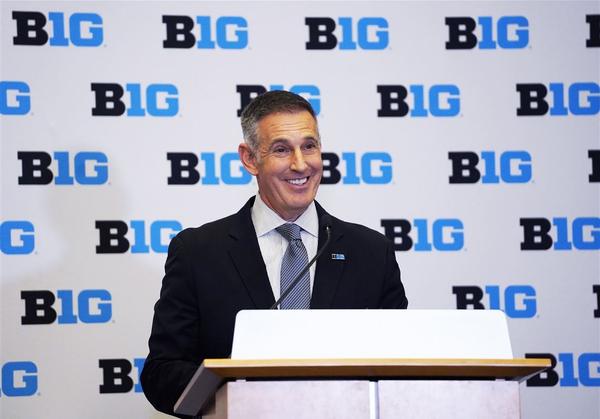
📖 The history
The GIST: The last three years have seen more shifting alliances than a season of Survivor. But even though this wave of realignment feels sudden and unprecedented, conference moves are nearly as old as college sports, and the current deluge has roots in a 1980s lawsuit: NCAA v. Board of Regents.
The court case: In 1981, an association representing multiple conferences inked a TV deal with NBC, while the NCAA, which had exclusively regulated all college sports TV contracts since 1952, had deals with ABC and CBS. The NCAA threatened sanctions to any school appearing on NBC, leading multiple programs to sue the governing body.
- In June 1984, the U.S. Supreme Court found the NCAA in violation of antitrust laws, opening the door for schools to further monetize media rights — and make conference moves that would generate the maximum amount of dough.
The last big boom: College sports have been movin’ and shakin’ ever since: There have been more than 200 Division I (DI) football conference changes since 1990, including the 1994 birth of the Big 12, all leading to a landscape dominated by the Power Five conferences: the ACC, Big 12, Big Ten, SEC, and Pac-12.
- After the 2012 announcement that Maryland and Rutgers would expand the Big Ten to 14 teams, conference moves quieted for nearly a decade, until…
🌊 The current wave

The GIST: With a single tweet that broke the NCAA Twitter-sphere on July 21, 2021, the latest era of massive conference shifts emerged. Here’s a timeline showing how we went from the Power Five to the Power Four era…and who might be eyeing future moves of their own.
July 2021: Texas and Oklahoma announced they would join the SEC when their media rights contract with the Big 12 expired in 2025, but they quickly grew impatient and negotiated to leave a year early. Today, the Longhorns and Sooners are officially SEC programs, with competitive debuts set for just a few weeks from now.
- With their biggest brands bailing, the Big 12 veered towards collapse. So in September 2021, the conference preemptively reloaded by adding BYU, UCF, Cincinnati, and Houston from the Group of Five’s American Athletic Conference last year. Cue Destiny’s Child.
June 2022: UCLA and USC announced their bombshell move from the Pac-12 to the Big Ten for the 2024–25 school year, creating the nation’s first coast-to-coast conference. Then, all hell broke loose.
August 2023: Panic drove the rest of the Pac-12 to scatter: Arizona, Arizona State, Utah, and Colorado bounced to the Big 12, and Washington and Oregon fled for the Big Ten. A few weeks later, Stanford and Cal caught the last train to the ACC (and SMU nudged their way into the deal, leveling up to Power conference status). They’ll play under their new banners this coming season. Still weird.
- Oregon State and Washington State were left behind in the Pac-12’s wreckage, earning themselves the �“Pac-2” moniker and a tenuous (but hopeful) future.
TBD: As money and power consolidate in the Big Ten and SEC, some wonder if we’re headed for a two-superconference future. The Big 12 and ACC are scrambling to keep up — although that’s growing significantly harder for the latter, as Florida State and Clemson are looking to make moves of their own.
💰 The motives

The GIST: So what’s driving this recent realignment frenzy? It’s the forces that make the entire sports world go ’round: money, fandom, and ego. Thanks to the negotiating power granted to conferences in the aforementioned NCAA v. Board of Regents case, TV deals are the name of the game.
The goldmine: Conferences collect on media rights deals with networks and streaming services, with funds passed onto member schools via revenue-sharing agreements. The aforementioned consolidation of power in the Big Ten and SEC is due, in part, to their massive and growing negotiating capabilities on that front.
- USC and UCLA’s decision to ditch the Pac-12 was influenced by the Big Ten’s recent seven-year, $7 billion deal with NBC, CBS, and FOX — a deal that puts between $80 million and $100 million per year in each member school’s pocket.
The prestige: Although there are plenty of talented athletes and teams outside the Power Four, the most elite NCAA competition and the most DI national champs are found in those four conferences. That means the Power Four garners more media attention, more opportunities to go pro, and more clout in the college sports space.
- And revenue-sharing isn’t the only boon media rights deals offer. Better partnerships mean more exposure, bigger fanbases, and better networking opportunities, all of which are crucial for attracting talent in the new NIL era.
- There are, of course, notable exceptions, like hoops powerhouse UConn, which recently returned to the Big East after an AAC stint and has little interest in transitioning to the Power Four. After all, the Big East basketball queens and kings are doing just fine on their own.
Enjoying this article? Want more?

Sign up for The GIST and receive the latest sports news straight to your inbox three times a week.

